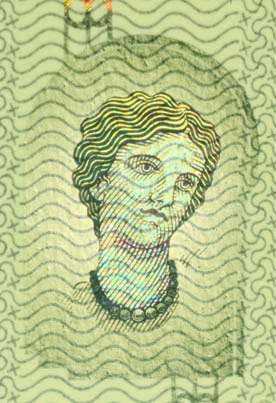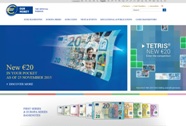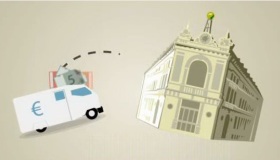Caracteristics of the new banknotes series "Europa"
 |
€5: Classical €10: Romanesque €20: Gothic €50: Renaissance €100: Baroque and rococo €200: 19th century iron and glass architecture €500: 20th century architecture |
An independent banknote designer based in Berlin, Reinhold Gerstetter, was selected to refresh the design of the euro banknotes.
Dominant colours will be used for each note and they will contrast with the "adjacent" notes in respect of their value. Each banknote denomination in the second series will have the same colour as in the first series, i.e. grey for €5, red for €10, blue for €20, orange for €50, green for €100, yellow-brown for €200. The Europa series will not include a €500 banknote, as explained in its press release of 4 May 2016.
The new banknotes also take into account the countries which joined the European Union in 2004 and 2007 after the launch of the first series. The notes show:
- the name of the currency, euro, not only in the Latin (EURO) and Greek (EYPΩ) alphabets but also in the Cyrillic (EBPO) alphabet, as a result of Bulgaria joining the European Union in 2007;
- a revised map of Europe, including Malta and Cyprus; and
- the initials of the European Central Bank in nine linguistic variants. The abbreviations are ordered according to the EU protocol order for countries and for the official languages and correspond to the following combinations of countries and official languages:
|
Serial numbers on the Europa series of banknotes
The serial numbers on this series are the two numbers printed on the back of the banknote: a horizontal number printed in black and a vertical number printed in a different colour. The horizontal number comprises two letters and ten digits. The first letter identifies the printing works – see the list below. The second letter has no particular meaning; it simply makes more serial numbers possible.
Printing works and letters
| Nationale Bank van België/Banque Nationale de Belgique | Z |
| Bank of Greece | Y |
| Giesecke & Devrient GmbH (Munich) | X |
| Giesecke & Devrient GmbH (Leipzig) | W |
| IMBISA | V |
| Banque de France | U |
| Central Bank of Ireland | T |
| Banca d'Italia | S |
| Bundesdruckerei GmbH | R |
| Joh. Enschede Security Printing BV | P |
| Oesterreichische Banknoten und Sicherheitsdruck GmbH | N |
| Valora | M |
| Not assigned | L |
| Not assigned | K |
| De La Rue Currency (Gateshead) | J |
| De La Rue Currency (Loughton) | H |
| Not assigned | G |
| Oberthur Fiduciaire AD (Sofia) | F |
| Oberthur Fiduciaire SAS (Chantepie) | E |
| Polska Wytwórnia Papierów Wartościowych | D |
| Not assigned | C |
| Not assigned | B |
| Not assigned | A |







